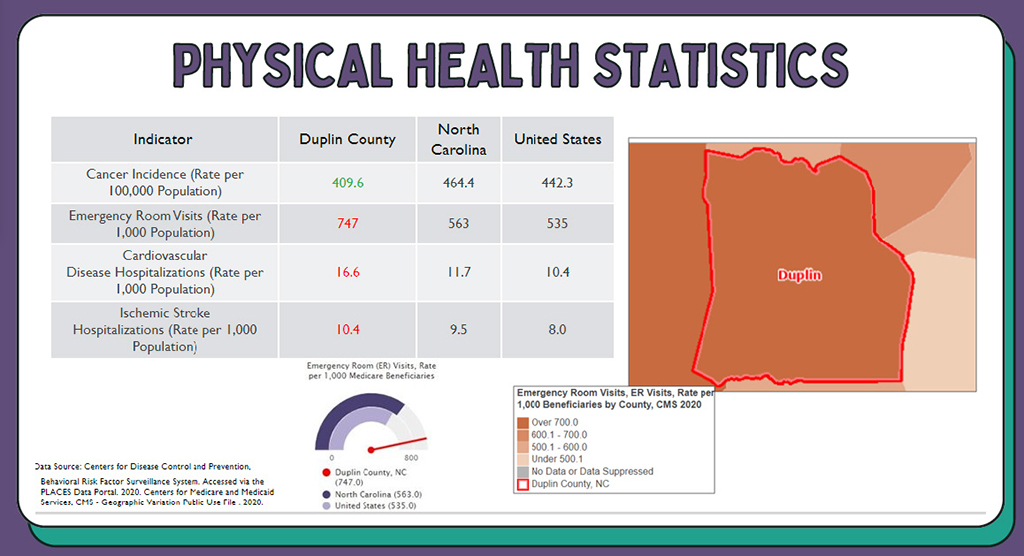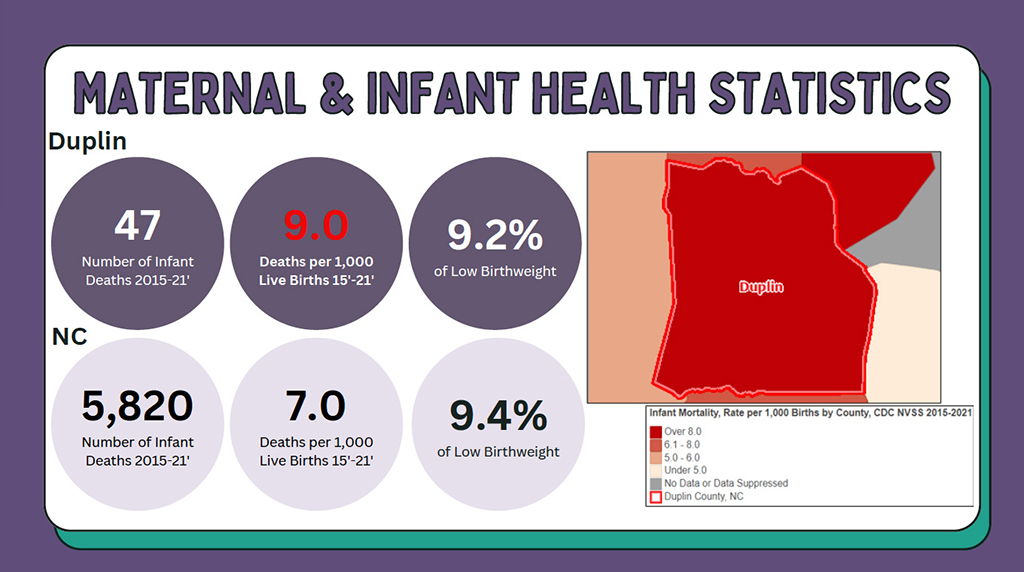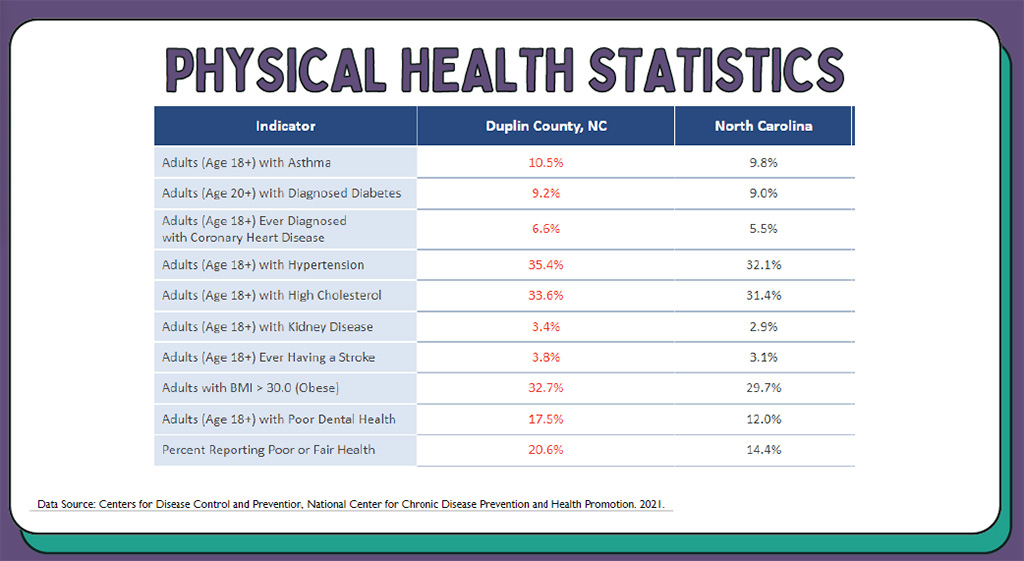KENANSVILLE — Last week, Tracey Simmons-Kornegay, Duplin County Health director, presented the Duplin County Community Health Needs Assessment data findings to the Board of County Commissioners.
According to Kornegay, the population has decreased by about 10% compared to the last census. Currently, 46,923 people live in Duplin County.
“The Hispanic Latino [community] is about twice as much in Duplin County compared to the state,” said Kornegay, emphasizing that 14% of Duplin County residents are foreign-born, 5% higher than the state average. Also, 12.2% of Duplin residents have limited English proficiency, a number that is almost three times higher than the state average.
Kornegay highlighted that 23% of Duplin County residents receive food stamps, 10% more people than the state.
Uninsured youth, who are 18 and younger, account for more than double the state rate. Also, the number of uninsured residents in the 19-34 age group is 12% higher than that of the state.
“In the Social Vulnerability Index (SVI), Duplin County is at .86 and that is out of a 1.0 scale. We are number 15 in the state with sort of the highest number,” said Kornegay.
The SVI is used to identify communities that are especially at risk during public health emergencies due to socioeconomic factors, household composition, minority status, etc.
Kornegay explained that of the ECU Health system, eastern North Carolina region, nine counties out of 15 make up those with the most needs.
The Duplin Coalition for Health has identified access to care, chronic disease prevention, mental health, and substance abuse as the priority focus areas for 2024-2027.

“We will develop our strategic plan for the next three years based on this information and present it to the Board of Health,” explained Kornegay.
According to Kornegay, the top health problems affecting Duplin residents are diabetes, alcohol and drug addiction, obesity, heart disease/ high blood pressure, and mental health.
The health director also noted that there are nine deaths per 1,000 live births in Duplin County.

“That is significant for us as we look at infant health as well as prenatal maternal health,” said Kornegay, explaining that they have recently rolled out a new program called Centering for Pregnancy. With this program, the health department expects better health outcomes as patients will have more time with the provider, and it will also empower moms with patient-centered healthcare.
“Over one-third of Duplin County adults suffer from hypertension, high cholesterol, or diabetes,” said Kornegay, adding that Duplin residents also report a higher average number of days with poor mental health.
To address those needs, the health department partnered with NC STEP and Tarheel Human Services to provide psychotherapy and telepsychiatry services. It has received funding from Trillium to help serve Duplin’s underserved and uninsured population.
Kornegay explained that some of the problems affecting the community’s health are the availability and access to doctors, poverty, and insurance. To alleviate those factors, they partnered with NC Medicis to provide medications at no charge or at a reduced rate for the uninsured and with ECU Health’s pediatrics department and Goshen Medical to provide physicals for children.

“Our plan is to continue to work with everyone to try to offer more affordable care at the health department. We do provide a sliding fee scale for patients if they do bring in their income,” said Kornegay. “Communicable disease, STDs, immunizations, and tuberculosis services are at no charge. And then additionally, there are enhanced services that have been elected to be provided at the health department due to the lack of access that we have in the county.”
Kornegay also highlighted a few health behaviors of concern.
“The state average [of teens giving birth] is 18.2, Duplin County is 37.2. So, that is quite significant for us here in the county,” said Kornegay. “Additionally, we have seen an increase in babies born to mothers with syphilis.”
As of October 2024, there have been 64 incidences of gonorrhea, 242 of chlamydia, 76 of syphilis and 3 of HIV. And five babies were born to moms with syphilis.
Kornegay explained that some of the things the health department is doing as it relates to sexual health are condom distribution, STD screenings, treatments, and oral contraceptives.
Tobacco use is about 5% higher than the state. According to state data, one in eight high school students use a tobacco product. The estimated number of Middle schoolers using tobacco in NC is 18,600, and for high schoolers, it is 57,300, with the number one tobacco product used by youth being e-cigarettes.
“Almost three people in each classroom have access to or use tobacco products. So, if you guys have children, one of three in their class has access to or uses tobacco products,” said Kornegay. Currently, the county is focusing on early intervention and program referrals.
Health factors addressed include broadband access, houses without computers, liquor stores, drinking water safety, housing units in flood hazard areas, housing, homelessness, and transportation for households without motor vehicles.
In terms of food security, Duplin is performing below the state with 13% compared to the state’s 11% food insecurity. Also for child food insecurity at 20% compared to North Carolina at 15%. In 2023, the health department and area partners distributed 1,255 food boxes between March, April, November, and December.
“The health department over the last several years has participated in some community food drives. They started in COVID, and we’ve continued those post-COVID,” said Kornegay, adding that they host one during Easter, Thanksgiving, and Christmas to provide food for the county’s residents. “We have a lot of community partners who come out to this event to try to help serve the residents of the county.”
In other business:
The board approved a public hearing for the Nov. 18 meeting to discuss the proposed 2025 revaluation schedule of property values. A copy of the proposed rates is available for public inspection in the Tax Assessor’s Office at the Hardison Building, 117 Beasley St., Kenansville.
“Our objective is to be fair to all of the citizens of Duplin County and market value is our number one priority. But we can share information on the agriculture community, farmland prices, residential houses, and various neighborhoods in the county,” said Gary Rose, tax administrator, after presenting the board with a schedule of rates used to evaluate and price property in Duplin County. Rose gave an example of a 1,500-square-foot one-story home with a two-car garage and vinyl siding, costing $229,600.
The board approved an expenditure of $4,500 from the opioid fund to create an assessment map as part of an initiative with the Eastern Carolina Council to identify gaps that can be addressed through regional collaboration.
“The analysis will be separated by county, so we’ll know what we look like, as well as aggregated by sub-regions and the full regional area. This process will produce cost savings and benefit estimates for expansion of specific opioid and substance use disorder prevention, treatment, or injury prevention infrastructure, and projections with the expansion of the model,” explained County Manager Bryan Miller, adding that the process will take between nine and 12 months. “Opioid funds are available to cover the cost. And with the approval, will be added to the existing opioid third resolution.”
Miller explained that this would enable them to identify areas where they cannot provide treatment or access to information. He shared as an example that a regional strategy would be effective for establishing a treatment facility, while for educational components, the health department is managing quite well, and a county-focused approach may be sufficient in that aspect.
“If we’re talking about county approaches, then whatever gaps are there, we’re able to fill the gaps. And I think that’s the important part of this. We don’t know where the gaps are until we do an analysis like this,” said Miller. “What this brings to the table is the strategic mindset and the ability of the Recovery Alliance Institute to bring different sectors of the community and the region together to identify where the pitfalls are. The other thing it’s going to do is assess what our needs are going to be three and five years out and see what assets we have in place and see if they’re going to be adequate to cover those needs three and five years out.”
 Twitter
Twitter Facebook
Facebook Instagram
Instagram





